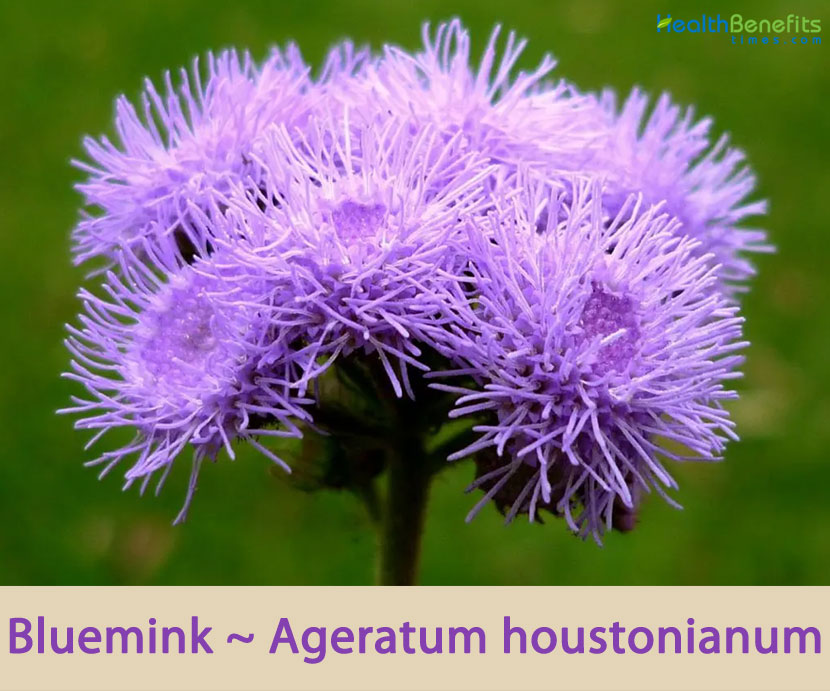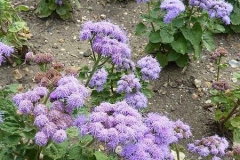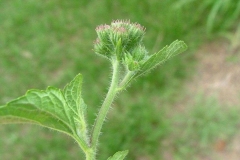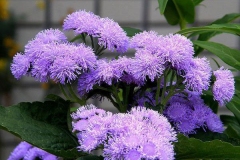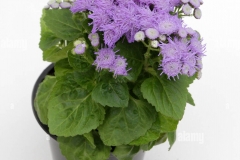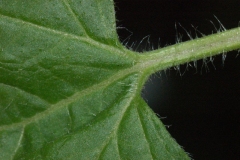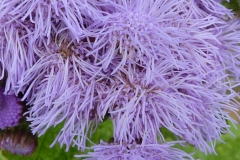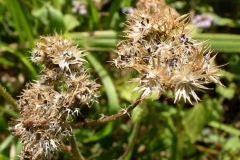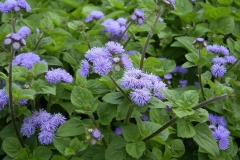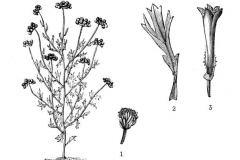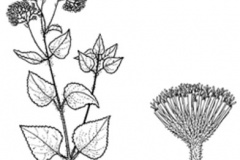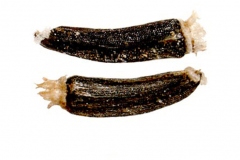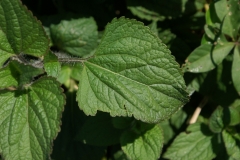| Bluemink Quick Facts | |
|---|---|
| Name: | Bluemink |
| Scientific Name: | Ageratum houstonianum |
| Origin | Mexico and Central America |
| Colors | Brown to black |
| Shapes | Achene that are about 2 mm long, brown to black in color, and topped with five awn-tipped scales (i.e. a pappus). |
| Health benefits | arthrosis, headache, dyspnea, muscle spasms, flatulence, diarrhea or abdominal cramps, menstrual cramps |
| Name | Bluemink |
|---|---|
| Scientific Name | Ageratum houstonianum |
| Native | Mexico and Central America. It was brought to Europe shortly after its discovery. The species is reported as invasive in China, Taiwan (PIER, 2016), Mozambique, Swaziland, Tanzania, Zimbabwe, USA (Hawaii), Cuba, Peru, Australia, Fiji, French Polynesia, New Zealand |
| Common Names | Ageratum, billy goat crofton, billy goat weed, billygoat weed, blue billy goat weed, blue billygoat weed, blue top, bluemink, bluetop, dark bluetop, floss flower, flossflower, garden ageratum, goat weed, goatweed, invading ageratum, Mexican ageratum, Todd’s curse, tropic ageratum, blueweed, pussy foot, Mexican paintbrush |
| Name in Other Languages | Afrikaans: Mexikaanse ageratum Armenian: Antseri mek’sikakan (Անծերի մեքսիկական) Assamese: Gendali-bon, Gondh-bon Belarusian: Ahieratum mieksikanski (агератум мексіканскі) Bulgarian: Ageratum (агератум) Chinese: Zi hua huo xiang ji, xiong er cao (熊耳草), Shèng hóng jì (勝紅薊), Mòxīgē lán jì (墨西哥藍薊), Duàn xuè cǎo (斷血草), Zǐhuā máo shèxiāng (紫花毛麝香), Zǐhuā huò xiāng jì (紫花藿香薊), Chòu cǎo zǐ (臭草仔) Croatian: Meksička plavuša Cuba: Celestina azul Czech: Nestařec americký Danish: Almindelig blåkvast Dutch: Leverbalsem, mexicaantje English: Bluemink, Flossflower, Mexican ageratum, Ageratum, Blue billygoat-weed, Garden ageratum, Blue maudlin, blue-top goatweed, large-flower ageratum Fijian: Botebotekoro, mbotembotekoro, sogovanua, songovanua Finnish: Sinitähtönen, meksikonsinitähtönen French: Ageratum du Mexique, Agerate bleu, eupatoire bleue, German: (Mexikanischer) Leberbalsam, Gewöhnlicher Leberbalsam, Mexikanischer Leberbalsam, Mexiko-Leberbalsam Hawaiian: Maile hohono, maile honohono, maile kula Hindi: Raktarodhi Hungarian: Kék bojtocska, bojtocska Italian: Agerato celestino Japanese: Murasakikakkoazami (ムラサキカッコウアザミ), Ookakkoazami (オオカッコウアザミ), ageratsumu (アゲラツム), katsukô-azami (カツコウアザミ), Kakkouazami (カッコウアザミ) Korean: Bul ro hwa (불로화) Lithuanian: Meksikinis žydrūnis Macedonian: Sina dzvezdička (Сина ѕвездичка) Nepali: Nilo Gandhe (निलो गन्धे), Gandhe Jhaar (गन्धे झार) Norwegian: Blåkorg, Blåkurv Polish: Żeniszek meksykański, ageratum meksykańskie, Portuguese: Agerato, celestina Russian: Ageratum Gaustona (Агератум Гаустона), ageratum meksikanskiy (агератум мексиканский), ageratum Houstona (агератум Хоустона) Sanskrit: Nilima Serbian: Ageratum (Агератум) Slovak: Agerát mexický Spanish: Agerato, agerato celestino, damasquino Swedish: Ageratum, Leverbalsam Ukrainian: Ageratum gaustona (агератум гаустона) Welsh: Ageratwm |
| Plant Growth Habit | Short-lived, cool-season, erect, herbaceous annual or dwarf shrub |
| Growing Climates | Gardens, roadsides, disturbed sites, waste areas, pastures, crops, wetlands, waterways, farmlands, forest trails, riverbanks, cleared upland slopes, crests, pine woods, cultivated ground, savannas, humid areas, riparian zones, pine woods, coastal area |
| Soil | Well drained soils are preferred with some added organic matter and a layer of mulch |
| Plant Size | 10 to 70 centimeters tall. The plants usually grow to a width of 10 to 30 centimeters |
| Stem | Stems are simple or branched, especially above, erect or decumbent, reddish to green, glandular-villous to lanate above. The stem is covered in white, soft matted hairs (tomentose) or woolly hairs (lanate) |
| Leaf | Oppositely arranged, but can be alternately arranged on the upper parts of the stems. They are borne on stalks (i.e. petioles) 0.5-3 cm long and vary from being almost triangular in shape to egg-shaped in outline (i.e. ovate). These leaves are 2-7 cm long and 1.5-6 cm wide and have bluntly toothed (i.e. crenate) margins and either blunt or pointed tips (i.e. obtuse to acute apices) |
| Flowering season | June to October |
| Flower | Each flower-head is 5-8 mm across and has numerous tiny tubular flowers (i.e. tubular florets) that are surrounded by two or three rows of greenish-coloured bracts (i.e. an involucre). The florets are 2-3 mm long and range from pale lavender to blue, pink or purplish in color and each has two elongated projections (i.e. style branches). The bracts at the base of the flower-head is 3-5 mm long and are elongated in shape (i.e. linear-lanceolate) and covered in sticky hairs (i.e. glandular pubescent). |
| Fruit Shape & Size | Achene that are about 2 mm long, brown to black in color, and topped with five awn-tipped scales (i.e. a pappus). These scales are 2-3 mm long and are whitish in color and resemble short bristles or hairs |
| Fruit Color | Brown to black |
| Propagation | By seed |
| Plant Parts Used | Leaves, fruits, flowers, stem, seeds, roots |
| Varieties |
|
| Season | August to October |
| Other Facts |
|
Plant Description
Bluemink is a short-lived, cool-season, erect, herbaceous annual or dwarf shrub that normally grows about 10 to 70 centimeters tall. The plants usually grow to a width of 10 to 30 centimeters. The plant is found growing in gardens, roadsides, disturbed sites, waste areas, pastures, crops, wetlands, waterways, farmlands, forest trails, riverbanks, cleared upland slopes, crests, pine woods, cultivated ground, savannas, humid areas, riparian zones, pine woods and coastal area. Well drained soils are preferred with some added organic matter and a layer of mulch. It is sometimes cultivated and is often a weed in nursery stock. It can be found occasionally as an escape or weed in plant nurseries, in landscaped areas, and around disturbed urban areas such as parking lots or drainage ditches. It is a fibrous rooted annual plant. Stems are simple or branched, erect or decumbent, reddish to green, glandular-villous to lanate above. Stem is covered in white, soft matted hairs (tomentose) or woolly hairs (lanate).
Leaves
The leaves are mostly oppositely arranged, but can be alternately arranged on the upper parts of the stems. They are borne on stalks (i.e. petioles) 0.5-3 cm long and vary from being almost triangular in shape to egg-shaped in outline (i.e. ovate). These leaves are 2-7 cm long and 1.5-6 cm wide and have bluntly toothed (i.e. crenate) margins and either blunt or pointed tips (i.e. obtuse to acute apices). Both surfaces of the leaves and the leaf stalks have a scattered covering of hairs (i.e. they are pubescent).
| Leaf arrangement | Alternate |
| Leaf type | Simple |
| Leaf margin | Dentate |
| Leaf shape | Ovate |
| Leaf venation | Reticulate |
| Leaf type and persistence | Not applicable |
| Leaf blade length | 2 to 4 inches |
| Leaf color | Green |
| Fall color | Not applicable |
| Fall characteristic | Not applicable |
Flowers
The flower-heads (i.e. capitula) are arranged in dense clusters at the tips of the branches (i.e. in terminal corymbs) and do not have any obvious petals (i.e. ray florets). Each flower-head is 5-8 mm across and has numerous tiny tubular flowers (i.e. tubular florets) that are surrounded by two or three rows of greenish-coloured bracts (i.e. an involucre). The florets are 2-3 mm long and range from pale lavender to blue, pink or purplish in color and each has two elongated projections (i.e. style branches). The bracts at the base of the flower-head is 3-5 mm long and are elongated in shape (i.e. linear-lanceolate) and covered in sticky hairs (i.e. glandular pubescent). Flowering occurs throughout most of the year but more during June to October.
| Flower color | Blue; pink; lavender |
| Flower characteristic | Showy |
Fruit
Fertile flowers are followed by achene that are about 2 mm long, brown to black in color, and topped with five awn-tipped scales (i.e. a pappus). These scales are 2-3 mm long and are whitish in color and resemble short bristles or hairs. Plants are somewhat similar to our native Blue Mistflower (Conoclinium coelestinum, which is also occasionally called Wild Ageratum.
| Fruit shape | No fruit |
| Fruit length | No fruit |
| Fruit cover | No fruit |
| Fruit color | Not applicable |
| Fruit characteristic | Inconspicuous and not showy |
History
The plant is native to Central America in Guatemala and Belize, and adjacent parts of Mexico, but has become an invasive weed in other areas. It was also naturalized in large parts of the tropics and in the southern United States. Their habitat is pastures, moist forest clearings and bushes up to altitudes of 1,000 meters (3,300 ft.).
Today, it is extensively used as an ornamental plant for summer borders and balcony boxes, high varieties also as cut flowers. The species is cultivated once a year, having numerous varieties whose crowns may be dark blue, purple, pink and white.
Traditional uses and benefits of Bluemink
- The juice of the plant is used externally to treat cuts and wounds.
- The juice is used in folk medicine as an external wound healing aid for skin injuries.
- Weed has been used past time for its medicinal effect in numerous diseases such as common wound and the burned one, anti-microbe, arthrosis, headache, and dyspnea.
- The infusion of its leaves help to recover from muscle spasms and arthritis problems.
- It is also ideal to improve some digestive problems such as flatulence, diarrhea or abdominal cramps.
- It is an effective reliever of menstrual cramps.
- Rheumatic pains are also relieved when the infusion is applied together with alcohol.
- Juice of the plant helps prevent infection in wounds promoting rapid healing.
- In Ecuador, the plant is used to treat throat pain or inflammation in folk medicine.
Precautions
- Ageratum houstonianum is toxic to grazing animals, causing liver lesions.
- Parts of plant are poisonous if ingested.
- All parts of plant are poisonous if ingested.
- Handling plant may cause skin irritation or allergic reaction.
- Plant has spines or sharp edges; use extreme caution when handling.
- Pollen may cause allergic reaction.
References:
http://www.hear.org/pier/species/ageratum_houstonianum.htm
https://pfaf.org/user/Plant.aspx?LatinName=Ageratum+houstonianum
https://www.cabi.org/isc/datasheet/3573
https://gd.eppo.int/taxon/AGEHO
http://www.theplantlist.org/tpl1.1/record/gcc-11706
https://en.wikipedia.org/wiki/Ageratum_houstonianum
https://www.inaturalist.org/taxa/120944-Ageratum-houstonianum
https://keyserver.lucidcentral.org/weeds/data/media/Html/ageratum_houstonianum.htm
https://indiabiodiversity.org/species/show/265318
https://www.itis.gov/servlet/SingleRpt/SingleRpt?search_topic=TSN&search_value=36483#null
https://npgstest2.agron.iastate.edu/gringlobal/taxon/taxonomydetail?id=1761
https://en.hortipedia.com/Ageratum_houstonianum
http://hort.ufl.edu/shrubs/AGEHOUA.PDF
https://apg.pir.sa.gov.au/gringlobal/taxonomydetail.aspx?id=1761
https://davesgarden.com/guides/pf/go/256/#b
http://www.flowersofindia.net/catalog/slides/Floss%20Flower.html
https://plants.usda.gov/home/plantProfile?symbol=AGHO3
https://www.missouribotanicalgarden.org/PlantFinder/PlantFinderDetails.aspx?taxonid=277131


